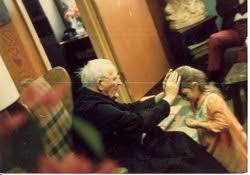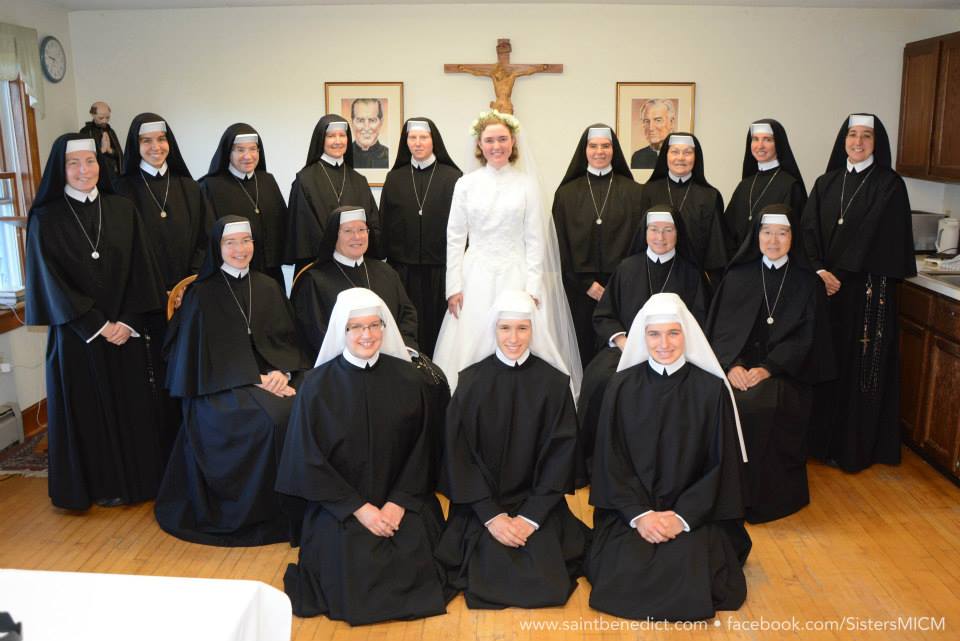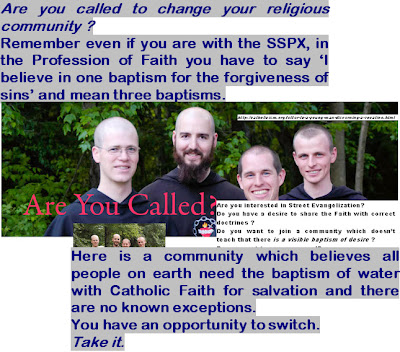
Thursday, August 9, 2018
Repost : Hypothetical references in the Letter of the Holy Office 1949, Vatican Council II and the Catechism of the Catholic Church are mistaken as being non hypothetical by the St. Benedict Centers : clarification needed
AUGUST 4, 2018
Hypothetical references in the Letter of the Holy Office 1949, Vatican Council II and the Catechism of the Catholic Church are mistaken as being non hypothetical by the St. Benedict Centers : clarification needed


Hypothetical references are mistaken as being non hypothetical by the St. Benedict Centers, the communities of Fr. Leonard Feeney in the USA. Over the last 50- plus years they have supported wrong doctrine.
They interpreted the Letter of the Holy Office 1949 with hypothetical cases not being hypothetical. They were in some way, actual people, in their mind, relevant to the dogmaextra ecclesiam nulla salus(EENS).

Then references to hypothetical cases inVatican Council II,for the St.Benedict Centers were interpreted as not being hypothetical. They became known people saved outside the Church. So this would, of course, be a rejection of the dogma EENS by the Council. So they rejected Vatican Council II.



Then hypothetical cases in the Catechism of the Catholic Church (1994), were also non hypothetical and objective for them, and so there was a rupture with the dogma EENS.
Once they correct the error Vatican Council II and the Catechism of the Catholic Church will not be a rupture with Feeneyite EENS.They simply have to affirm Vatican Council II, the Catechism of the Catholic Church and Feeneyite EENS.


The ecclesiology of the Catholic Church for them today, would be the same as at the time of Fr.Leonard Feeney, Sr. Catherine Goddard Clarke MICM and Brother Francis Malus MICM.Thetheology of the Church would be the same. There would be no change in mission-motivation.It would be the same as it was for the Jesuits in the 16th century.



They must clarify however that they affirmVatican Council II, with hypothetical cases just being hypothetical and it is the same with theCatechism of the Catholic Church.It is the same with the Letter of the Holy Office 1949.



They must clarify however that they affirmVatican Council II, with hypothetical cases just being hypothetical and it is the same with theCatechism of the Catholic Church.It is the same with the Letter of the Holy Office 1949.


So they affirm the first part of the Letter of the Holy Office and reject the Second Part which contradicts the first part.It is irrational and violates the Principle of Non Contradiction.-Lionel Andrades











-Lionel Andrades


Repost : No Restoration with Cushingism.Not possible : There is not going to be a Restoration with Cushingism.Mattei and Ferrara are part of the problem. So is Whispers of Restoration and 1Peter5
AUGUST 5, 2018
There is not going to be a Restoration with Cushingism.Mattei and Ferrara are part of the problem. So is Whispers of Restoration and 1Peter5
Whispers of Restoration should have an article on Vatican Council II( Feeneyite). I have said it a few times. There is no comment from them.They are another traditionalist Cushingite website.They sell books written by Chris Ferrara and Roberto dei Mattei who base their understanding of Vatican Council II and EENS upon the upon the heresy in the Letter of the Holy Office 1949(LOHO).There is no comment coming from them or from others from the Lefbrivist school of traditionalists.A few years have pased and they have no opinion on this issue.


Can the baptism of desire have two interpretations? No answer.
The Letter of the Holy Office 1949 has been teaching heresy when it says every one does not need to be a member of the Catholic Church, for salvation.Since the Letter reasons wrongly that invisible and unknown cases of the baptism of desire, baptism of blood and invincible ignorance are objective and practical exceptions to the de fide teaching, on all needing to be a member of the Church for salvation( Cantate Domino, Council of Florence 1441).How can invisible cases of non Catholics be an an exception to traditional EENS according to the old catechisms? Yet this is how Ferrara and Mattei reason.So they have nothing to say. This is how they reasoned for 50 years.
It's the same story on the website 1Peter5 and traditionalist bloggers.The only food they serve at their tables is Cushingite.No choice.They interpret all magisterial documents in only one way.
Someone said ,"This is what the Church teaches ".But the Church also supports Vatican Council II (Cushingite) so why do they reject it?
If they feel obliged to follow Pius XII they why not also John XXIII and Paul VI ?
The interpretation of Vatican Council II according to the Left and the present two popes is heretical.It is the same with EENS.
The website Whispers of Restoration presents itself as being traditionalist but they support the official and liberal heresy on salvation. If they avoid the LOHO mistake it's a new Vatican Council II.It would not be the traditionalism of Archbishop Lefebvre and the SSPX bishops who supported Cardinal Richard Cushing and Pope Pius XII.


The theology of the websites Whispers of Restoration and 1Peter5 is based on LOHO.It is irrational.They can allegedly see people in Heaven and on earth saved without the baptism of water.This is also the interpretation of the Masons.The LOHO mistake is used to create a rupture with Tradition(EENS, Syllabus of Errors etc).
We have to reject the second part of the LOHO, which is irrational and non traditional,and then we can have a traditional interpretation of Vatican Council II.
Today's 'traditionalists' are not really traditional especially the Lefebvrist school.Since they are in a rupture with the old ecclesiology of the Church which was Feeneyite and is expressed in the traditional Catechisms available on the website Whispers of Restoration.
Today's 'traditionalists' are not really traditional especially the Lefebvrist school.Since they are in a rupture with the old ecclesiology of the Church which was Feeneyite and is expressed in the traditional Catechisms available on the website Whispers of Restoration.
They are in a rupture with EENS and the past ecclesiology since BOD,BOB and I.I are exceptions to EENS for them.
FR.CEKADA POLITICALLY CORRECT
I think of Fr. Anthony Cekada who now knows that there are no known cases of BOD, BOB and I.I in the present times and there were none in the past.But he keeps repeating his old line on 'Feeneyism',since it is politically correct.He does not have it in him to apologize and correct himself and others on this issue.
FR.CEKADA POLITICALLY CORRECT
I think of Fr. Anthony Cekada who now knows that there are no known cases of BOD, BOB and I.I in the present times and there were none in the past.But he keeps repeating his old line on 'Feeneyism',since it is politically correct.He does not have it in him to apologize and correct himself and others on this issue.
If he announces that he has started to interpret Vatican Council II and EENS with Feeneyism, in which hypothetical cases are just hypothetical and not objective exceptions to EENS, the Left may not allow him to teach.It is the same with Bishop Donald Sanborn who has politically correct articles on Feeneyism(according to the Left) on line.So their sedevacantist seminary and that of the 'Novus Ordo' seminaries in Florida,which they criticize have the same Cushingite approach to Vatican Council II etc.There is no difference in theology, new doctrines and worldly prudence among both groups there.So they are given the mandatum to teach from the bishops and the local secular authorities.They have compromised on doctrine and theology in real life.

It was the same at the recent Lepanto FoundationConference in Rome when the New Theology was being criticized by the speakers, who in reality use the New Theology, Cushingism, to interpret Vatican Council II, the Catechisms and EENS.Roberto dei Mattei and John Lamont like Fr. Anthony Cekada remain politically correct with the Left.All is well. It is as if they use the LOHO mistake to stay alive.

It was the same at the recent Lepanto FoundationConference in Rome when the New Theology was being criticized by the speakers, who in reality use the New Theology, Cushingism, to interpret Vatican Council II, the Catechisms and EENS.Roberto dei Mattei and John Lamont like Fr. Anthony Cekada remain politically correct with the Left.All is well. It is as if they use the LOHO mistake to stay alive.
Similarly it seems difficult for Louis Verrecchio to say that UR 3 in Vatican Council II refers to a hypothetical case.I e-mailed him the correction.This was not the first time. There is no comment from him, for or against. It's as if he does not understand.

UR 3 refers to a hypothetical and theoretical cases for us and not someone practically seen in Heaven, saved as a Protestant in his religion.What's so difficult to understand about this?
He will continue to interpret UR 3 as being a non Catholic who has been saved outside the Church and is known personally to him. So of course it becomes a rupture with the dogma EENS.


UR 3 refers to a hypothetical and theoretical cases for us and not someone practically seen in Heaven, saved as a Protestant in his religion.What's so difficult to understand about this?
He will continue to interpret UR 3 as being a non Catholic who has been saved outside the Church and is known personally to him. So of course it becomes a rupture with the dogma EENS.

Roberto dei Mattei and Chris Ferrara wrote books on Vatican Council II not knowing about the difference between Cushingism and Feeneyism( according to L.A) in the interpretation of the Council.The website Whispers of Restoration is promoting these books.
There is not going to be a Restoration with Cushingism. Mattei and Ferrara are part of the problem. So is Whispers of Restoration and1Peter5.
-Lionel Andrades
Traditional Catechisms on Whispers of Restoration support the old exclusivist ecclesiology but the team at the website interpret these catechisms as a rupture with the Syllabus of Errors,EENS and the rest of Tradition




The traditional Catechisms on the website Whispers of Restoration(WR) support the old exclusivist ecclesiology of the Catholic Church but the team at WR interpret these catechisms as a rupture with the Syllabus of Errors and the past ecclesiology of the Church.Since for WR, the baptism of desire(BOD), the baptism of blood(BOB) and being saved in invincible ignorance(I.I) are exceptions to the dogma extra ecclesiam nulla salus (EENS).Since they are exceptions, it indicates BOD, BOB and I.I are known people saved outside the Church.People in Heaven are exceptions on earth to the dogma EENS?!

They are known and visible to be exceptions is the false reasoning at WR.
For the website-team BOD, BOB and I.I refer to visible and not invisible non Catholics/Catholics saved outside the Church.Known people saved outside the Church without the baptism of water.There cannot be any such person. Only God would know if it was possible for someone to be saved outside the Church.




So the Nicene Creed for them becomes, 'I believe in three or more baptisms for the forgiveness of sins. They are the baptism of desire, blood and invincible ignorance and they all exclude the baptism of water.I also believe in the baptisms of the seeds of the Word(AG 11), imperfect communion with the Church (UR 3) etc, as known baptisms which exclude the baptism of water in the Catholic Church.'
So the traditional Catechisms on WR, are a rupture with the ecumenism of returm (Syllabus of Errors) and the de fide teaching on all needing to be members of the Catholic Church to avoid Hell and go to Heaven ( Council of Florence 1441, Cantate Domino).WR says there are exceptions.Exceptions means a rupture. It means a break with exclusive salvation in the Catholic Church.




For example the old Catechism of Pope Pius X mentions being saved in invincible ignorance. For me being saved in invincible ignorance refers to an invisible person on earth.But for the team at WR, being saved in invincible ignorance and without the baptism of water, refers to a known person and so is an exception to Feeneyite EENS.
Yes a visible person saved outside the Church as such would be an exception to EENS and the past ecclesiology of the Church - but there is no such person in our reality.


Similarly the Catechism of the Council of Trent mentions the case of the unknown catechumen, known only to God.Again this person is physically invisible in our reality.But for the team at WR, the baptism of desire refers to known people saved outside the Church.So the Catechism of the Council of Trent becomes a rupture with the dogma EENS, the Syllabus of Errors and the past ecclesiology as it was known to the Magisterium in the 16th century.
With visible cases of the baptism of desire being examples of salvation outside the Church, of course, there would be a rupture with Tradition- but practically there are no such cases.-Lionel Andrades


Subscribe to:
Posts (Atom)
















